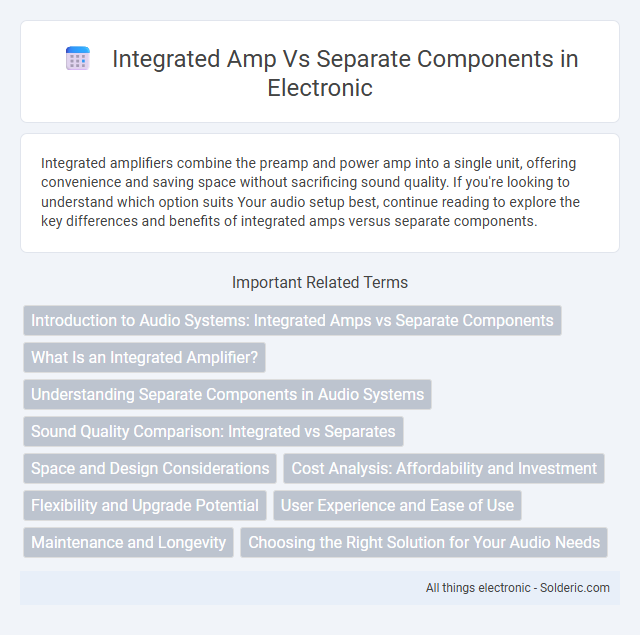Integrated amplifiers combine the preamp and power amp into a single unit, offering convenience and saving space without sacrificing sound quality. If you're looking to understand which option suits Your audio setup best, continue reading to explore the key differences and benefits of integrated amps versus separate components.
Comparison Table
| Feature | Integrated Amplifier | Separate Components |
|---|---|---|
| Design | Combines preamp and power amp in one unit | Separate preamplifier and power amplifier units |
| Cost | More affordable, budget-friendly | Higher cost due to multiple units |
| Sound Quality | Good, but limited upgrade options | Superior, with customizable components |
| Space | Compact, saves space | Requires more room |
| Flexibility | Less flexible for upgrades and modifications | Highly flexible, allows component upgrades |
| Complexity | Simple setup and operation | Complex setup, more cables |
| Use Case | Ideal for casual listeners and small spaces | Ideal for audiophiles and customizable systems |
Introduction to Audio Systems: Integrated Amps vs Separate Components
Integrated amps combine a preamplifier and power amplifier into one unit, offering a compact, cost-effective solution with simplified connectivity for your audio system. Separate components consist of individual preamps and power amps, providing greater flexibility, customization, and potential for higher sound quality by allowing you to select each element based on your preferences. Choosing between integrated amps and separate components depends on your priorities for space, budget, and audio performance in your setup.
What Is an Integrated Amplifier?
An integrated amplifier combines a preamplifier and power amplifier into a single unit, streamlining your audio setup while maintaining high-quality sound output. It simplifies connectivity by reducing the number of components and cables needed, making it ideal for users seeking convenience without sacrificing performance. Integrated amplifiers often include features like tone controls, input switching, and headphone outputs, enhancing versatility within a compact design.
Understanding Separate Components in Audio Systems
Separate components in audio systems consist of individual elements such as a standalone amplifier and a preamplifier, offering greater flexibility and customization for audiophiles seeking tailored sound quality. These components allow you to upgrade or replace parts independently, enhancing system longevity and performance optimization. High-quality separates often deliver superior sound clarity, dynamic range, and power handling compared to integrated amplifiers.
Sound Quality Comparison: Integrated vs Separates
Separate components typically offer superior sound quality due to dedicated circuitry for the amplifier and preamplifier, reducing interference and allowing for more detailed audio reproduction. Integrated amps combine these functions in one unit, which may introduce signal noise or limit power output, potentially impacting clarity and dynamic range. Audiophiles often prefer separates for their enhanced soundstage and precision, while integrated amps provide a cost-effective, space-saving solution with respectable audio performance.
Space and Design Considerations
Integrated amplifiers combine preamplifier and power amplifier functions into a single unit, significantly reducing the footprint and simplifying cable management compared to separate components. Separate components offer more flexibility in system upgrades and customization but require more space and careful planning for component placement to avoid clutter and signal interference. For compact living spaces or minimalist setups, integrated amps provide a streamlined design with fewer connection points, enhancing overall aesthetic and ease of installation.
Cost Analysis: Affordability and Investment
Integrated amplifiers offer a cost-effective solution by combining a preamplifier and power amplifier into a single unit, reducing both initial purchase price and space requirements compared to separate components. Separate amplifiers allow for tailored upgrades and potentially higher audio fidelity but often come with a higher cumulative cost due to purchasing individual units and compatible equipment. Budget-conscious audiophiles benefit from integrated systems, while those seeking long-term investment and customization tend to prioritize separate components despite the increased financial commitment.
Flexibility and Upgrade Potential
Separate components offer greater flexibility and upgrade potential, allowing you to mix and match high-quality preamps, power amps, and DACs to tailor your audio system precisely to your preferences. Integrated amplifiers consolidate these components into one unit, limiting individual upgrades but simplifying setup and saving space. For audiophiles seeking long-term customization and scalability, separate components provide a more adaptable foundation for evolving sound systems.
User Experience and Ease of Use
Integrated amplifiers streamline user experience by combining preamplifier and power amplifier functions in a single unit, simplifying setup and reducing cable clutter. Separate components often provide more customization and superior sound quality but require more knowledge for proper integration and can increase complexity in operation. Users seeking convenience and space-saving solutions typically prefer integrated amps, while audiophiles valuing flexibility and detailed tuning lean towards separate components.
Maintenance and Longevity
Integrated amplifiers typically require less maintenance due to their all-in-one design, reducing the number of connections and potential failure points compared to separate components. Separate systems offer easier individual part replacement and upgrades, which can extend the overall longevity of your audio setup by allowing you to replace or service specific components. Choosing between integrated amps and separate components depends on your preference for convenience versus the flexibility to maintain and upgrade parts independently.
Choosing the Right Solution for Your Audio Needs
Integrated amplifiers combine preamp and power amp functions in one unit, offering convenience and space-saving benefits ideal for compact setups. Separate components provide superior audio quality and customization options, allowing audiophiles to tailor each element to specific preferences. Your choice depends on balancing space, budget, and desired sound performance to achieve the best audio experience.
Integrated amp vs Separate components Infographic

 solderic.com
solderic.com